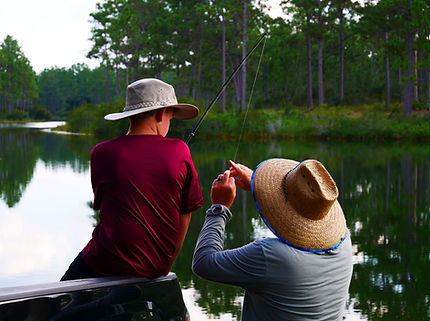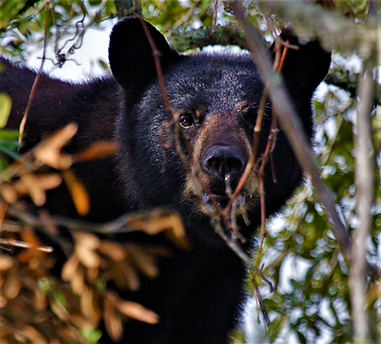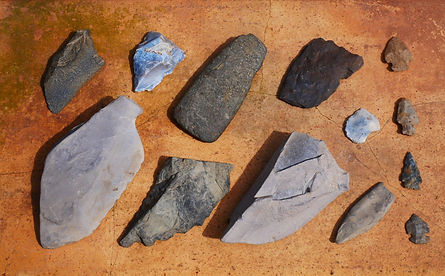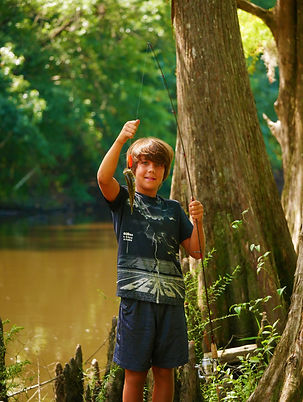Bagdad Living Com

Yellow River

Garnier Landing - Yellow River

Yellow River is a spectacular sand-bottom wilderness river flowing for 110 miles from its head waters in Alabama to its mouth in Blackwater Bay. As part of the Pensacola Bay Estuarine System, Yellow River provides a rich and diverse habitat for flora and fauna and is a major contributor of fresh water for the Bay system.
(Left) Yellow River is an ideal habitat for the Federally protected American alligator (Alligator mississippiensis) where numbers have stabilized through long term recovery efforts.
As one of Florida’s freshwater resources, Yellow River’s water supply and water quality are continuously monitored. Through the protection and management of its floodplains and natural systems, a large portion of Yellow River is shielded from the impacts of development and further habitat destruction.


(Above) The Great Egret (Ardea alba) is one of Yellow River's largest wading birds. Conservation efforts provide for a rich wetland habitat where this bird can feed on fish, amphibians, invertebrates and small mammals. Reptiles such as snakes and juvenile alligators are also on its diet.
Yellow River is unique in that it drains the state’s highest elevation. Its drainage basin is made up of approximately 1,365 square miles. Another 499 square miles are drained by the Shoal River, its main tributary. The combination of both rivers has an impressive discharge averaging 2,289 cubic feet per second.
(Above) Commonly known as a water moccasin, a baby Cotton-mouth (Agkistrodon piscivorus conanti) can be mistaken for a Southern Copperhead. While both have bright, sulfur-yellow tails in their juvenile stage, a Cottonmouth's eye is obscured by a dark facial band.
(Right) Yellow River is unique in that it drains the state's highest elevation. Locals refer to the area as the 'Yellow River Valley'.

The majority of the land surrounding Yellow River has been acquired by the state for water management purposes. Boundaries within the Yellow River Water Management Area are defined with signage from the corresponding agencies.

(Left; Right) Boundaries within the Yellow River Water Management Area are defined with signage from the corresponding agencies.

On the lower reach of Yellow River, eleven thousand acres have been set aside as the Yellow River Marsh Aquatic Preserve. The preserve includes portions of Blackwater Bay and East Bay, and is recognized as some of the most pristine waters in the state.
(Right) This aerial photo, taken by Rick Pascal, encompasses a large portion of the Yellow River Marsh Aquatic Preserve. The eleven-thousand acre preserve includes por-tions of Blackwater Bay, East Bay, and the lower reach of Yellow River, and is recog-nized as some of the most pristine waters in the state of Florida.

Yellow River Marsh
Aquatic Preserve

(Left) Before constructing the new US 90 (SR 10) bridge over Yellow River, a plan for relocating three species of freshwater mussels was devised along with measures to protect the Gulf Sturgeon during its migration season. The state of Florida has designated Yellow River as a critical habitat for these and many other threatened species.
Click on the logo above to link to Florida's Designated Paddling Trails
Yellow River is part of the real Florida experience where residents and visitors are impacted by the ever-changing scenery and profound sense of the wild. Recreational opportunities range from hunting, fishing, and wildlife observation to other types of nature appreciation as well as most forms of boating.
As part of the statewide Green-ways and Trails System, 54 miles (86.9 km) of the upper Yellow River is a Florida Designated Paddling Trail.
(Right) Milligan Park Boat Ramp provides boat access to the Yellow River just south of Hwy 90 on Ellis Rd. It is one of seven access points along the Yellow River Paddling Trail.
(Below) A father and son sport their fishing hats at Duck Pond on Eglin Air Force Base Reservation.

Milligan Park Boat Ramp


One of the most explored areas of Yellow River is the undeveloped wetlands and upland forests of Eglin Air Force Base Reservation. A total of 250,000 acres have been set aside as the Eglin Air Force Base Wildlife Management Area.
(Right) Known for its beautifully clear water and sandy white bottom, the lower reach of Boiling Creek is one of nine Paddle Trails found on the Eglin Reservation. A permit allows conditional use of the reservation for a wide range of recreational activities including access to Eglin's Paddle Trails.
An Eglin Reservation permit allows conditional use of the reservation for fishing, hunting, biking, and primitive camping as well as hiking the Florida National Scenic Trail. The permit also allows access to Eglin's Paddle Trails.

(Right) The Florida National Scenic Trail meanders through some of Eglin Reservation's most beautiful, unique landscapes which include old-growth longleaf pine forests, sandhill uplands, and steep-head ravines. The visibly marked trail gives hikers a chance to see wildlife and camp in designated areas.
More than 106 Federally Listed Plant and Animal Species are found on the Eglin reservation where sixty-three of these are consider globally rare. Eglin’s Natural Resources Management Plan provides for the long-term protection of sensitive species through habitat restoration and preservation practices.
Click on the logo above to link to
Florida National Scenic Trail

(Above) Springing from a dense clump of rhizomes, the slightly fragrant flower of the Crimson pitcherplant appears just before or along with the forming pitchers between March and April.
(Below) The Crimson pitcherplant (Sarracenia leucophylla Raf.) is a native carnivorous plant scattered amongst Eglin reservation's various wetlands including upland seepage bogs, wet meadows, and moist flats in pine savannas. It is a listed vulnerable species on the IUCN Red List of Threatened Species due to lack of natural wildfires and loss of its unique wetland habitat.

One of the threatened species that benefits from conservation efforts on Yellow River is the Gulf sturgeon. This subspecies of sturgeon returns from the Gulf of Mexico each year to its natal stream for spawning. Yellow River is cited as a Critical Habitat for this species which relies on healthy water conditions to exist.

Photo courtesy Ryan Hagerty, USFWS

Still-image courtesy of US Fish & Wildlife Service
(Above) The Gulf sturgeon (Acipenser oxyrinchus desotoi) is listed as a threatened species by the federal government and a species of special concern by the state of Florida. Yellow River is one of the three last high-quality spawning areas in Florida for the Gulf sturgeon.
(Left) Biologists monitor Gulf sturgeon on Yellow River by using a safe catch-and-release method for collecting data. This prehistoric fish can reach up to nine feet long and weigh as much as 300 pounds. Click here to watch video.
Preservation of the habitat surrounding Yellow River ensures that threaten and endangered species have the best chance of survival. Many species that reside in or migrate through the Eglin reservation corridor are protected by the Florida Fish and Wildlife Conservation Commission (FWC) and have well-developed programs designed for their conservation, management, or recovery.

(Above) Eglin Air Force Base, Blackwater River State Forest, and the Conecuh National Forest make up the largest contiguous acreage of old-growth longleaf pine/wiregrass ecosystem left in the world. As a whole, they provide for the movement of wildlife in the Northwest region of Florida through the Florida Wildlife Corridor system.

Photo courtesy of FWC - GFBWT
The Florida black bear and the American alligator are perhaps the most desired of these protected species to see. Yellow River is an ideal habitat for the Alligator where numbers have stabilized through long term recovery efforts.
(Left) The Florida black bear (Ursus americanus floridanus) has increased in numbers through extensive protection and conservation measures. While numbers are up, only about 120 bears live in the panhandle west of the Choctawhatchee River. Fruits, nuts, and berries amount to 80 percent of their diet; another 15 percent comes from insects such as termites, ants, and yellow jackets. The remaining 5 percent consists of meat from animals such as opossums, armadillos, and carrion.
For the Florida black bear, habitat preservation is crucial for recovery.
Additional Strategic Habitat Conservation Areas (SHCAs) are needed to increase their security and range. Sighting either one of these species while exploring is a highlight for residents and visitors alike.


(Above) The Great Blue Heron (Ardea herodias) depends on wetlands for feeding and on relatively undisturbed sites for breeding. Like many other species, they are vulnerable to habitat loss and to impacts such as logging, motorboats, and other human intrusions that can disrupt nesting colonies.
(Left) The Florida banded water snake (Nerodia fasciata pictiventris) is a nonvenomous snake often mistaken for the venomous Cottonmouth. This brightly colored newborn will turn darker with age where its markings will appear more subdued.
Historically, the Lower Creeks were the original occupants of this area. As part of the Muscogee Creek nation, they were a highly civilized people engaged in agriculture and grazing. Seasonal migrations down Yellow River were common for them to harvest fish and a variety of shellfish.


(Above) Fishing on the Yellow River is a way of life for many local residents. Leanne Bennett holds up a fine bass caught by lifelong resident, Regina Fowler (seated).
(Left) The Lower Creeks were a highly civilized people engaged in agriculture and grazing. Tools and points made of stone were thought to have been brought with them during their seasonal migrations to the coast. The sample shown here could facilitate the need for piercing, scraping, cutting, and pounding.

(Above) Jonah Bennett holds up a nice bream from his fishing hole on Yellow River where he pulled in an assortment of fish including a Florida gar.
In later years, European migration brought about many changes to the landscape and to the economy as progress pushed forward. A rippling impact would soon follow once the lumber industry was introduced to the area. As a result, many small communities, camps, and mills sprang up along Yellow River.
(Right) River's Edge Campground is located off Log Lake Road where logging activity associated with the silviculture industry still exists. A lacy canopy of Cypress and Juniper over-hang a nearby slough creating a serene place to explore.
(Below) This cabin dates back to the original owners of Garnier Landing. Landings along the Yellow River were places where passengers and cargo could embark or come ashore as the most common way of travel was by boat. Other landings along Yellow River include Gin Hole Landing, Carr Landing, Mason Landing, Sweetgum Landing, Flowers Field Landing, and Faulks Ferry Landing.

River's Edge Campground


Fisher Old Mill Boat Ramp
(Below Left; Below Right) The shallows of an oxbow on Yellow River at Fisher Old Mill Boat Ramp highlight the river's namesake. A slough towards the west of the ramp might have facilitated a small mill operation at this location.
The river was vital for these sites as the most common way to reach them was by boat. It also facilitated the transporta-tion of the area's natural resources which included the prized Longleaf yellow pine as well as Live oak, Cypress, and Juniper.

Some of the other valued resources were sedimentary clays used for brick making and fish harvested from the river itself. Towns and communities were built upon the abundance of these resources; their fate would inevitably depend on how long the supplies would last.
(Right) Efforts to control erosion on Eglin Reservation have significantly improved water quality entering Yellow River from runoff. Benefits are wide-spread as many endemic species depend on Yellow River's pristine water conditions to survive.
(Below) Pine Bluff Lake is situated in a beautiful sweeping bend of Yellow River. Nearby are some of the area's highest bluffs where dramatic changes in topography occur. Other bluffs along the river are Wilkinson Bluff, Metts Bluff, and Miller Bluff.


Pine Bluff Lake
Unfortunately, the striping and depletion of timber from the land proved to be detrimental for the economy as well as the environment. Besides the loss of habitat, vast areas of erosion negatively affected the water conditions of Yellow River. This left a once-thriving ecosystem in a fragile state with many of its species imperiled or on the brink of extinction.
Today, the State of Florida and the Federal Government are continuing to work towards the protection and restoration of Yellow River as one of our most important ecosystems.
(Right) Miller Bluff was once the site of a thriving community dating back to the 1800s. Today, the privately owned riverfront is bordered on three sides by the Yellow River Wildlife Management Area. Across the Yellow River are the Federally protected lands of Eglin Reservation.

Miller Bluff
By reflecting on our past, we can appreciate efforts to restore and manage our natural resources responsibly as all living organisms depend on each other and on their environments to meet their needs for survival.
(Right) The Highway 87 Bridge spans for almost a mile over Yellow River where a vast expanse of wetlands and sloughs occur. This is the end-point for both the Yellow River Paddle Trail and the Boiling Creek Paddle Trail.

Yellow River Bridge - Hwy 87

Yellow River Marsh Aquatic Preserve

Mouth of Yellow River
As always, use care on the waterways. Be aware of weather, and river conditions before you launch. Adhere to FWC Regulations and Boating Safety Requirements.

Understand that most of Yellow River is remote wilderness where you are in control of your own personal safety.
Click on the FWC logo above
for Boating Safety link
Have a float plan and let someone know where you are going and when you are due back. By following these suggestions, one can expect to have a memorable experience exploring the unique wilderness of the Yellow River.

On behalf of BWFP and FPAN, we hope you visit the Historic Village of Bagdad. From our shores, you are welcome to launch into your own adventure on the beautiful Blackwater River and use the Blackwater Maritime Heritage Trail to enrich your experience.

Return
Yellow River Bridge - Hwy 90







